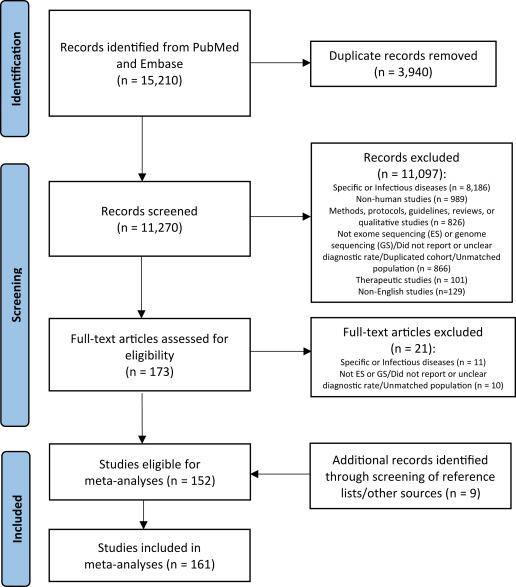Meta-analysis of the diagnostic and clinical utility of exome and genome sequencing in pediatric and adult patients with rare diseases across diverse populations |
| |
| Affiliation: | 1. Hong Kong Genome Institute, Hong Kong Special Administrative Region;2. Department of Paediatrics and Adolescent Medicine, School of Clinical Medicine, Li Ka Shing Faculty of Medicine, The University of Hong Kong, Hong Kong Special Administrative Region |
| |
| Abstract: | 
PurposeThis meta-analysis aims to compare the diagnostic and clinical utility of exome sequencing (ES) vs genome sequencing (GS) in pediatric and adult patients with rare diseases across diverse populations.MethodsA meta-analysis was conducted to identify studies from 2011 to 2021.ResultsOne hundred sixty-one studies across 31 countries/regions were eligible, featuring 50,417 probands of diverse populations. Diagnostic rates of ES (0.38, 95% CI 0.36-0.40) and GS (0.34, 95% CI 0.30-0.38) were similar (P = .1). Within-cohort comparison illustrated 1.2-times odds of diagnosis by GS over ES (95% CI 0.79-1.83, P = .38). GS studies discovered a higher range of novel genes than ES studies; yet, the rate of variant of unknown significance did not differ (P = .78). Among high-quality studies, clinical utility of GS (0.77, 95% CI 0.64-0.90) was higher than that of ES (0.44, 95% CI 0.30-0.58) (P < .01).ConclusionThis meta-analysis provides an important update to demonstrate the similar diagnostic rates between ES and GS and the higher clinical utility of GS over ES. With the newly published recommendations for clinical interpretation of variants found in noncoding regions of the genome and the trend of decreasing variant of unknown significance and GS cost, it is expected that GS will be more widely used in clinical settings. |
| |
| Keywords: | Genomic diversity Meta-analysis Rare disease Exome sequencing Genome sequencing |
| 本文献已被 ScienceDirect 等数据库收录! |
|

